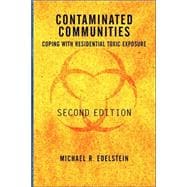
Note: Supplemental materials are not guaranteed with Rental or Used book purchases.
Purchase Benefits
What is included with this book?
| Foreword to the First Edition | p. ix |
| Preface to 2004 Edition | p. xi |
| Acknowledgments | p. xiii |
| Toxic Exposure: The Plague of Our Time | p. 1 |
| The Plague as a Metaphor for Toxic Exposure | p. 2 |
| Contaminated Communities | p. 6 |
| Contamination as a Widespread Event | p. 7 |
| Defining a Contaminated Community | p. 9 |
| The Stages of Toxic Disaster | p. 19 |
| Collateral Damage in the Risk Society | p. 22 |
| The Theory of Environmental Turbulence | p. 24 |
| Summary and Outline of the Book | p. 32 |
| Legler: The Story of a Contaminated Community | p. 35 |
| A Methodological Note | p. 35 |
| Groundwater Contamination in Legler | p. 37 |
| Period of Incubation | p. 38 |
| Discovery and Announcement | p. 50 |
| Disruption of Lifestyle: Water Delivery | p. 55 |
| The Hookup of City Water | p. 59 |
| Lingering Concerns | p. 59 |
| Afterword About the Landfill's Afterlife | p. 62 |
| Lifescape Change: Cognitive Adjustment to Toxic Exposure | p. 65 |
| Defending Our Prior Assumptions | p. 65 |
| Perceiving a Changed Status | p. 66 |
| Perceptions of Health | p. 71 |
| Inherent Uncertainty | p. 73 |
| Confirmed Exposures | p. 78 |
| Environment | p. 81 |
| Loss of Personal Control | p. 89 |
| The Inversion of Home | p. 93 |
| Loss of Social Trust | p. 104 |
| Conclusion: The Lifescape Impacts of Toxic Exposure | p. 118 |
| Individual and Family Impacts | p. 119 |
| Coping with Exposure: Individuals | p. 119 |
| Outcomes: Positive and Negative | p. 122 |
| Coping with Exposure: Couples | p. 136 |
| Coping with Exposure: Children | p. 141 |
| Case Studies of Family Dynamics | p. 147 |
| Stigmatized Relationships: Outsiders Just Don't Understand | p. 152 |
| Neighbors: Proximate Support | p. 158 |
| Summary: Individual and Family Impacts | p. 159 |
| Disabling Citizens: The Governmental Response to Toxic Exposure | p. 161 |
| A Dialectic of Double Binds | p. 162 |
| Communicational Distortion in the Institutional Context | p. 172 |
| Distortion and the Communication of Bad News | p. 176 |
| Differing Paradigms of Risk Between Citizens and Regulators | p. 178 |
| Institutional Contexts | p. 189 |
| Conclusion and Summary | p. 191 |
| The Enabling Response: Community Development and Toxic Exposure | p. 193 |
| Enablement Through Community Development | p. 193 |
| Keys to Enablement: Leadership and Activism | p. 195 |
| Key Benefits of Community Development | p. 197 |
| The Consensus/Dissensus Continuum | p. 201 |
| Consensus and Dissensus in Legler | p. 205 |
| Consensus and Dissensus Elsewhere | p. 209 |
| Toxic Victims: A New Social Movement? | p. 213 |
| Sustainability as a Metaenvironmental Justice Issue | p. 242 |
| Conclusion: A Radical Environmental Populism | p. 244 |
| The Societal Meaning of Pollution | p. 245 |
| Denial and the Culture of Contamination | p. 245 |
| Rejecting a Contaminating Culture: Local Environmental Resistance | p. 253 |
| Changing the Culture of Contamination | p. 274 |
| Cultural Immunity: Last Defense of the Contaminating Culture | p. 279 |
| Sustainability as the Third Stage of Modernity | p. 282 |
| Notes | p. 293 |
| Bibliography | p. 311 |
| Index | p. 339 |
| Table of Contents provided by Ingram. All Rights Reserved. |
The New copy of this book will include any supplemental materials advertised. Please check the title of the book to determine if it should include any access cards, study guides, lab manuals, CDs, etc.
The Used, Rental and eBook copies of this book are not guaranteed to include any supplemental materials. Typically, only the book itself is included. This is true even if the title states it includes any access cards, study guides, lab manuals, CDs, etc.